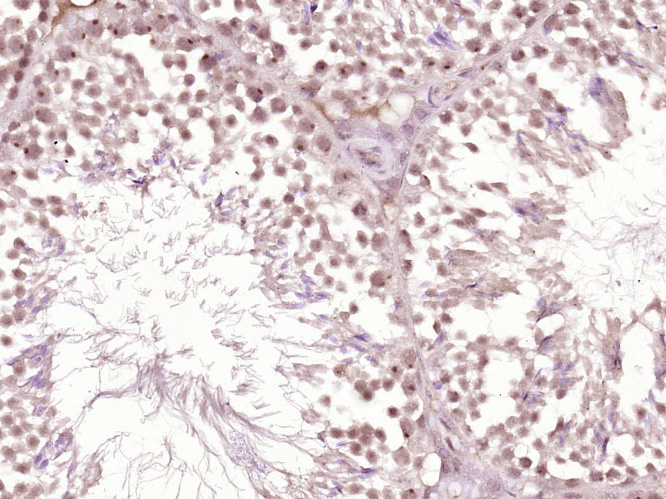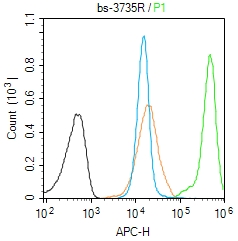
Rabbit Anti-phospho-DNA PKcs (Thr2609)antibody
DNA PKcs(phospho-Thr2609); PRKDC(phospho T2609); DNA PKcs (phospho T2609); p-DNA PKcs (phospho T2609); PRKDC_HUMAN; DNA-dependent protein kinase catalytic subunit; EC:2.7.11.1; PRKDC; HYRC; HYRC1; DNA-PK catalytic subunit; DNA-PKcs; DNPK1; p460;
View History [Clear]
Details
Product Name phospho-DNA PKcs (Thr2609) Chinese Name 磷酸化DNA依赖性蛋白激酶抗体 Alias DNA PKcs(phospho-Thr2609); PRKDC(phospho T2609); DNA PKcs (phospho T2609); p-DNA PKcs (phospho T2609); PRKDC_HUMAN; DNA-dependent protein kinase catalytic subunit; EC:2.7.11.1; PRKDC; HYRC; HYRC1; DNA-PK catalytic subunit; DNA-PKcs; DNPK1; p460; Product Type Phosphorylated anti Research Area Tumour Cell biology immunology transcriptional regulatory factor Kinases and Phosphatases Immunogen Species Rabbit Clonality Polyclonal React Species Human, Mouse, Applications ELISA=1:5000-10000 IHC-P=1:100-500 IHC-F=1:100-500 ICC=1:100-500 IF=1:100-500 (Paraffin sections need antigen repair)
not yet tested in other applications.
optimal dilutions/concentrations should be determined by the end user.Theoretical molecular weight 454kDa Cellular localization The nucleus Form Liquid Concentration 1mg/ml immunogen KLH conjugated Synthesised phosphopeptide derived from human PRKDC around the phosphorylation site of Thr2609: E(p-T)QA Lsotype IgG Purification affinity purified by Protein A Buffer Solution 0.01M TBS(pH7.4) with 1% BSA, 0.03% Proclin300 and 50% Glycerol. Storage Shipped at 4℃. Store at -20 °C for one year. Avoid repeated freeze/thaw cycles. Attention This product as supplied is intended for research use only, not for use in human, therapeutic or diagnostic applications. PubMed PubMed Product Detail This gene encodes the catalytic subunit of the DNA-dependent protein kinase (DNA-PK). It functions with the Ku70/Ku80 heterodimer protein in DNA double strand break repair and recombination. The protein encoded is a member of the PI3/PI4-kinase family.[provided by RefSeq, Jul 2010]
Function:
Serine/threonine-protein kinase that acts as a molecular sensor for DNA damage. Involved in DNA nonhomologous end joining (NHEJ) required for double-strand break (DSB) repair and V(D)J recombination. Must be bound to DNA to express its catalytic properties. Promotes processing of hairpin DNA structures in V(D)J recombination by activation of the hairpin endonuclease artemis DCLRE1C). The assembly of the DNA-PK complex at DNA ends is also required for the NHEJ ligation step. Required to protect and align broken ends of DNA. May also act as a scaffold protein to aid the localization of DNA repair proteins to the site of damage. Found at the ends of chromosomes, suggesting a further role in the maintenance of telomeric stability and the prevention of chromosomal end fusion. Also involved in modulation of transcription. Recognizes the substrate consensus sequence [ST]-Q. Phosphorylates 'Ser-139' of histone variant H2AX/H2AFX, thereby regulating DNA damage response mechanism. Phosphorylates DCLRE1C, c-Abl/ABL1, histone H1, HSPCA, c-jun/JUN, p53/TP53, PARP1, POU2F1, DHX9, SRF, XRCC1, XRCC1, XRCC4, XRCC5, XRCC6, WRN, MYC and RFA2. Can phosphorylate C1D not only in the presence of linear DNA but also in the presence of supercoiled DNA. Ability to phosphorylate p53/TP53 in the presence of supercoiled DNA is dependent on C1D.
Subunit:
DNA-PK is a heterotrimer of PRKDC and the Ku p70-p86 (XRCC6-XRCC5) dimer. Formation of this complex may be promoted by interaction with ILF3. Associates with the DNA-bound Ku heterodimer, but it can also bind to and be activated by free DNA. Interacts with DNA-PKcs-interacting protein (KIP) with the region upstream the kinase domain. PRKDC alone also interacts with and phosphorylates DCLRE1C, thereby activating the latent endonuclease activity of this protein. Interacts with C1D. Interacts with TTI1 and TELO2.
Subcellular Location:
Nucleus.
Post-translational modifications:
Phosphorylated upon DNA damage, probably by ATM or ATR. Autophosphorylated on Thr-2609, Thr-2638 and Thr-2647. Thr-2609 is a DNA damage-inducible phosphorylation site (inducible with ionizing radiation, IR). Autophosphorylation induces a conformational change that leads to remodeling of the DNA-PK complex, requisite for efficient end processing and DNA repair.
S-nitrosylated by GAPDH.
Similarity:
Belongs to the PI3/PI4-kinase family.
Contains 1 FAT domain.
Contains 1 FATC domain.
Contains 2 HEAT repeats.
Contains 1 PI3K/PI4K domain.
Contains 3 TPR repeats.
SWISS:
P78527
Gene ID:
5591
Database links:Entrez Gene: 5591 Human
Entrez Gene: 19090 Mouse
SwissProt: P78527 Human
SwissProt: P97313 Mouse
DNA依赖性蛋白激酶(DNA PKcs) 是哺乳动物细胞DNA损伤修复的关键酶,是哺乳类细胞蛋白质丝/苏氨酸激酶,位于The nucleus.Product Picture
Primary Antibody (green line): Rabbit Anti-phospho-DNA PKcs (Thr2609) antibody (SL3735R)
Dilution: 1μg /10^6 cells;
Isotype Control Antibody (orange line): Rabbit IgG .
Secondary Antibody (white blue line): Goat anti-rabbit IgG-AF647
Dilution: 1μg /test.
Protocol
The cells were fixed with 4% PFA (10min at room temperature)and then permeabilized with 90% ice-cold methanol for 20 min at room temperature. The cells were then incubated in 5%BSA to block non-specific protein-protein interactions for 30 min at room temperature .Cells stained with Primary Antibody for 30 min at room temperature. The secondary antibody used for 40 min at room temperature. Acquisition of 20,000 events was performed.
Bought notes(bought amounts latest0)
No one bought this product
User Comment(Total0User Comment Num)
- No comment




 +86 571 56623320
+86 571 56623320
 +86 18668110335
+86 18668110335

